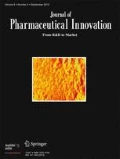Abstract
Recent concerns about the applicability of design space boundaries developed on small scale to commercial manufacturing processes have been raised by regulators worldwide. These concerns center around the scalability of unit operations and their corresponding process parameters, and the impact this has on the desired attributes of the drug substance or product. Requests have been made to verify design space boundaries with data generated at commercial scale. Because it is not always feasible to manufacture large-scale batches, alternative approaches to verification are necessary. The following article discusses various science-based strategies that could be used to verify design space boundaries. These approaches balance the requirements to address regulatory concerns and ensure that quality standards are maintained for both drug substances and products, within the operating constraints currently facing the pharmaceutical industry.


Similar content being viewed by others
Notes
The term “edge of failure” is used in this paper to describe a design space boundary that is associated with the acceptance criteria for an intermediate or release specification. Operating near this edge will result in intolerable reduction in the product yield. The point of failure is typically a gradient and not necessarily a sharp edge.
Defined as “An alternative approach to process validation in which manufacturing process performance is continuously monitored and evaluated,” ICH Harmonised Tripartite Guideline, Pharmaceutical Development Q8(R2) Step 4, August 2009.
References
ICH Harmonised Tripartite Guideline, Pharmaceutical Development Q8(R2), Annex to Pharmaceutical Development, Step 4, August 2009.
Neal G, Christie J, Keshavarz-Moore E, Shamlou P, Ayazi. Ultra scale-down approach for the prediction of full-scale recovery of ovine polycolonal immunoglobulins used in the manufacture of snake venom-specific Fab fragment. Biotechnol Bioeng. 2003;81:149–57.
Boychyn M, Yim S, Bulmer M, More J, Bracewell D, Hoare M. Performance prediction of industrial centrifuges using scale-down models. Bioprocess Biosystems Eng. 2004;26:385–91.
Hutchinson N, Bingham N, Murrell N, Farid S, Hoare M. Shear stress analysis of mammalian cell suspensions for prediction of industrial centrifugation and its verification. Biotechnol Bioeng. 2006;95:483–91.
am Ende M, Berchielli A. A thermodynamic model for organic and aqueous tablet film coating. Pharm Dev Tech. 2005;1:47–58.
Zhang X, Lionberger R, Davit B, Yu L. Utility of physiologically based absorption modeling in implementing quality by design in drug development. AAPS J. 2011;13(1).
Kuentz M. Drug absorption modeling as a tool to define the strategy in clinical formulation development. AAPS J. 2008;10(3).
Zhang Y, Johnson K. Effect of drug particle size on content uniformity of low-dose solid dosage forms. Int J Pharm. 1997;154(20):179–83.
Author information
Authors and Affiliations
Corresponding author
Rights and permissions
About this article
Cite this article
Garcia, T., McCurdy, V., Watson, T.N.J. et al. Verification of Design Spaces Developed at Subscale. J Pharm Innov 7, 13–18 (2012). https://doi.org/10.1007/s12247-012-9123-0
Published:
Issue Date:
DOI: https://doi.org/10.1007/s12247-012-9123-0



